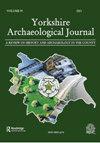Bronze Age and Later Vegetation History on the Limestone Tabular Hills of North-East Yorkshire, UK: Pollen Diagrams from Dalby Forest
IF 0.2
0 ARCHAEOLOGY
引用次数: 0
Abstract
Abstract This paper presents the results of palynological investigations on the limestone Tabular Hills of the North York Moors in north-east England. These limestone areas have the highest concentration of post-Mesolithic archaeological sites in this upland region, but because of the geology and paucity of suitable organic deposits they have had almost no palynological research with which to assess the land-use history of these cultures, nor their impacts on the vegetation. This lack of palaeoecological information from the Tabular Hills has been addressed, so that the area’s environmental history can be added to that of the rest of the North York Moors, which is relatively well known. Three pollen profiles have been examined, Yondhead Rigg providing an early Bronze Age to post-Medieval record, Seavy Slack providing a late Iron Age to post-Medieval record, and Dargate Dykes providing a late Medieval to modern record. The combined vegetation history from the three sites indicates a similar story to that from elsewhere on the Moors, with substantial forest disturbance in Bronze Age and Iron Age times, with significant woodland regeneration after each, but with the first main forest clearance phase for agriculture occurring during the Romano-British period, followed by early Medieval woodland regeneration, then extensive clearance in the later Medieval period for some arable cultivation and extensive animal husbandry on the rich calcareous grassland. In each agricultural phase the scale and intensity of disturbance seems to have been greater in these fertile limestone areas than in the rest of the Moors, with their poorer, more acidic soils, but still with an emphasis on stock-rearing and less extensive cultivation. The results will allow a more comprehensive landscape history of the North York Moors to be understood for later prehistory and more recent times.英国东北部约克郡石灰岩板状山丘上的青铜器时代和后来的植被历史:来自达尔比森林的花粉图
本文介绍了对英格兰东北部北约克摩尔石灰岩Tabular Hills的孢粉学研究结果。这些石灰岩地区是该高地地区中石器时代后考古遗址最集中的地区,但由于地质和缺乏合适的有机沉积物,他们几乎没有进行过孢粉学研究来评估这些文化的土地使用历史,也没有对植被的影响。Tabular Hills缺乏古生态信息的问题已经得到解决,因此该地区的环境历史可以添加到相对知名的北约克摩尔人的环境历史中。已经检查了三个花粉图谱,Yondhead Rigg提供了青铜时代早期到中世纪后的记录,Seavy Slack提供了铁器时代晚期到中世纪后记录,Dargate Dykes提供了中世纪晚期到现代的记录。这三个地点的综合植被历史表明,这与摩尔人其他地方的情况相似,青铜时代和铁器时代的森林受到了严重干扰,之后都有大量的林地再生,但第一个主要的农业森林砍伐阶段发生在罗马-不列颠时期,随后是中世纪早期的林地再生,然后在中世纪后期,在丰富的石灰质草原上进行了大规模的开垦,进行了一些可耕种的种植和广泛的畜牧业。在每个农业阶段,这些肥沃的石灰岩地区的干扰规模和强度似乎都比摩尔人的其他地区更大,那里的土壤更贫瘠、酸性更强,但仍然强调畜牧业和不太广泛的种植。研究结果将使人们能够更全面地了解北约克摩尔人的景观史,以便了解史前后期和近代。
本文章由计算机程序翻译,如有差异,请以英文原文为准。
求助全文
约1分钟内获得全文
求助全文

 求助内容:
求助内容: 应助结果提醒方式:
应助结果提醒方式:


